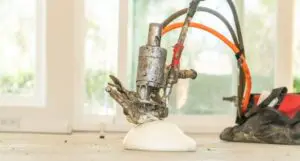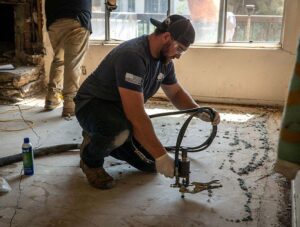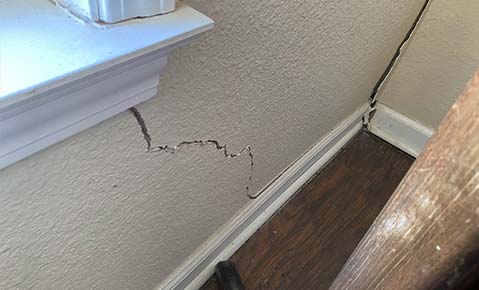
Would you believe there is a type of foam that can be as hard as concrete, yet far lighter? What if I told you it carries – or stabilizes – a building?
I know it’s hard to believe, especially when the types of foams we use are for shaving or memory foam feeling like you’re sleeping on a cloud. But polyurethane foam is used for construction, as well as many applications. Name a category. You’ll likely find out how polyurethane applies.
Dalinghaus Construction has used polyurethane for thousands of projects, which is no surprise after doing 2,000 foundation repair projects since 2015. After many years in construction, we understand how this stuff works and how much it can carry on its back. Its many applications are amazing when put to work.
What is deep injection with polyurethane?
It’s a pretty cool process for foundation repair Dalinghaus Construction can do. This involves putting tubes into the soil under your home or business with an injection gun to put in polyurethane foam. Voids and microvoids will be filled at different layers and densify the soil.
The primary function of deep injection with polyurethane foam is to densify soil and stabilize your home or business.
Why is polyurethane foam so awesome?

When it comes to being used in many applications, polyurethane foam is excellent for purposes like void fill, soil stabilization, and releveling.
You’re essentially “fixing” the soil when injecting polyurethane foam. The stuff expands rapidly, cures in 15 minutes, comes out as hard as concrete, 3-5 lbs per cubic foot, and is environmentally safe. So you don’t have to worry about contaminated soil with this stuff.
Polyurethane is so safe that it’s applied with pacemakers.
Polyurethane foam can relevel structures as small as a home or as large as a commercial business. Mind you, not a lot of lift happens. You’ll get maybe an inch or two under the best conditions, but it has that capability nonetheless.
Other aspects determine how effective polyurethane is for deep injection. It also depends on the type of foam used.
Other factors to consider: How strong is the foam? How deep was it injected? How dense does it go in?
Some polyurethane foam will be injected at 3,500 psi, which can be as hard as concrete. Lower psi can affect whether or not the foam can break apart. It can sometimes come out stronger than concrete.
How much can polyurethane foam carry?

Polyurethane foam can hold 5,000-10,000 pounds per cubic foot. It can sometimes get even higher than that depending on the foam and how it’s injected.
There have been instances where piers were used to lift a building, but it didn’t work. Then we brought in semi-trucks full of polyurethane foam that was then injected and able to lift the building. Four to five injection guns had to be used at once to lift the structure.
Deep injection with polyurethane foam can sometimes perform miracles when galvanized steel pier underpinnings struggle. But this is never guaranteed.
The main objective of polyurethane is soil stabilization, but the stuff can lift. We’ve lifted a bridge before. It can work.
Why carrying capacity is important
Again, the primary purpose is to densify the soil. That’s incredibly important when it comes to stabilizing your home or business with a slab-on-grade foundation, especially after lifting your home using a galvanized steel push pier and underpinning system.
Soil affects the effectiveness of polyurethane foam
With highly expansive soil, the foam cannot permeate as well compared to sandy soil. The soil will be pushed out and you’ll have blobs of polyurethane foam. You can still fill voids and do stuff with it.
When polyurethane foam is injected into the ground, it has nowhere to go. You can have highly expansive soil pushed away while the void is filled with foam. It mixed a little bit with whatever it can, but most of it is being pushed out.
Polyurethane foam can be used for shoring purposes
If we need to excavate, we can create a wall using deep injection with polyurethane foam.
If you have two buildings next to each other and one side needs to be looked at, the soil can be densified so the existing building won’t be affected by excavating. It helps with new construction.
Are there times deep injection with polyurethane is a bad idea?
Yes. If you want a guaranteed lift. Soil conditions don’t always allow for that.
If soil conditions are down further, a galvanized steel underpinning system would be better. Why? A ton of polyurethane foam material will be used, which isn’t cost-effective, especially when the cost is $110 per square foot. Driving a steel tube into the ground is far easier and better for your wallet.
Have a look at the cost of polyurethane and how the application affects cost.
Learn more about deep injection with polyurethane foam
You’ve learned about the basics of deep injection with polyurethane, why polyurethane is awesome, the carrying capacity of the stuff, its effectiveness with soil, and the cost per square foot. Take the time to learn more about polyurethane and deep injection.
We won’t make it a heavy burden for you. We have the article so you can have light work and a solid knowledge of how this stuff works.
And learn about how the deep injection with polyurethane foam process works.
Contact Dalinghaus Construction at (877)360-9277 if you have additional questions.





